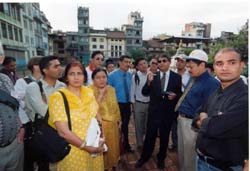|
|
 |
| AUDMP
MAKING CITIES SAFER |
Seminar on Institutional Arrangements for Total Risk Management: Visions for Thailand’s New Disaster Management Agency
More than 150 representatives from Thai government agencies responsible for disaster management attended a one and a half-day high-level seminar on Institutional Arrangements for Total Risk Management. It was organized by ADPC in collaboration with the Ministry of Interior of the Royal Thai Government from 3-4 April 2002 at the United Nations Conference Center in Bangkok. The seminar assisted the Thai government in establishing a new agency to deal with disaster management, which is scheduled to become operational by October 2002. A group of international experts and practitioners gave presentations on models of total risk management used in their countries. The concept of 4 R’s – readiness, relief, rehabilitation and reduction – was discussed throughout the seminar. The new disaster management paradigm of readiness and reduction was also extensively discussed.
Earthquake Vulnerability Reduction for Cities (EVRC-1) Course
|

|
|
Participants survey Patan Municipality buildings
|
More than 25 participants from six earthquake-prone countries (Bangladesh, India, Indonesia, Nepal, the Philippines and Turkey) attended the first regional course on Earthquake Vulnerability Reduction for Cities (EVRC-1) from 20-31 May 2002 in the world’s most earthquake-prone city, Kathmandu, Nepal.
EVRC is the fourth training course developed under AUDMP’s Training and Resource Materials and Continuing Education component. It was delivered by ADPC in collaboration with the National Society for Earthquake Technology (NSET)-Nepal, the World Seismic Safety Initiative (WSSI) and the Earthquakes and Megacities Initiative (EMI).
The ten-day course consisted of five modules on Earthquake Vulnerability Reduction (EVR) approaches and mitigation initiatives. The course contents covered an overview of urbanization, natural hazards, vulnerabilities, risks and disaster management, an in-depth study of earthquake hazard and vulnerabilities, and EVR methods, planning and implementation.
EVRC-1 is being offered in a shortened version before the upcoming 4th General Assembly of the Asian Seismological Commission (ASC) in November 2002 in Kathmandu. For more information, visit
http://safe.nset.org.np/ASC2002/
What is Social Marketing?
The relatively-new concept of “social marketing” was introduced at the recent 7th AUDMP Working Group Meeting in Bandung, Indonesia. The AUDMP monthly news featured a series of three articles in its April, May and June issues to provide a clear understanding of this subject. The articles were What is Social Marketing?, Elements of Social Marketing, and Social Marketing for Disaster Mitigation.
In social issue campaigns, public awareness is the most important element. Public awareness promotion activities are integral to any campaign’s success because they generate interest and enthusiasm among people towards a specific topic about which campaigners want to communicate. Social marketing was introduced in the 1970s by Philip Kotler and Gerald Zaltmanas to raise public awareness and influence change. They suggested that commercial marketing principles could be applied to social issues. Instead of selling profit-making products to consumers, the same principles can “sell” ideas, attitudes and behaviors.
Despite some similarities, the concept of social marketing is more complex than traditional commercial marketing. While the latter offers tangible benefits (for example, toothpaste and cars) in an exchange of money, social marketing does not involve economic transactions. Its abstract benefits are intangible (such as anti-smoking). The elements of social marketing are similar to those of commercial marketing. However, in addition to product, price, place and promotion, social marketing includes positioning, partnership, policy and politics. Social marketing has been extensively used in the health and environment sectors and is relatively new in disaster management.
| About
AUDMP
AUDMP is an eight-year
program designed to reduce the natural disaster vulnerability of
urban populations, infrastructure, critical facilities and shelter
in Asian cities. Currently, projects under the AUDMP are being
implemented in sites in nine countries - Bangladesh, Cambodia,
India, Indonesia, Lao PDR, Nepal, Philippines, Sri Lanka and
Thailand. Pipeline projects are planned in China and Vietnam. Core
funding for the AUDMP comes from the Office of Foreign Disaster
Assistance (OFDA) of the United States Agency for International
Development (USAID). Additional funds come from ADPC and
collaborating institutions in target countries. The program is
managed by USAID's Regional and Urban Development Office for South
Asia (RUDO/SA) and is implemented by ADPC in Bangkok, Thailand.
For
more information about AUDMP, please contact:
Tel: (662) 524 5354 Fax: (662) 524
5350
E-mail: audmp@ait.ac.th
Website: http://www.adpc.ait.ac.th/audmp/audmp.html
|
|


